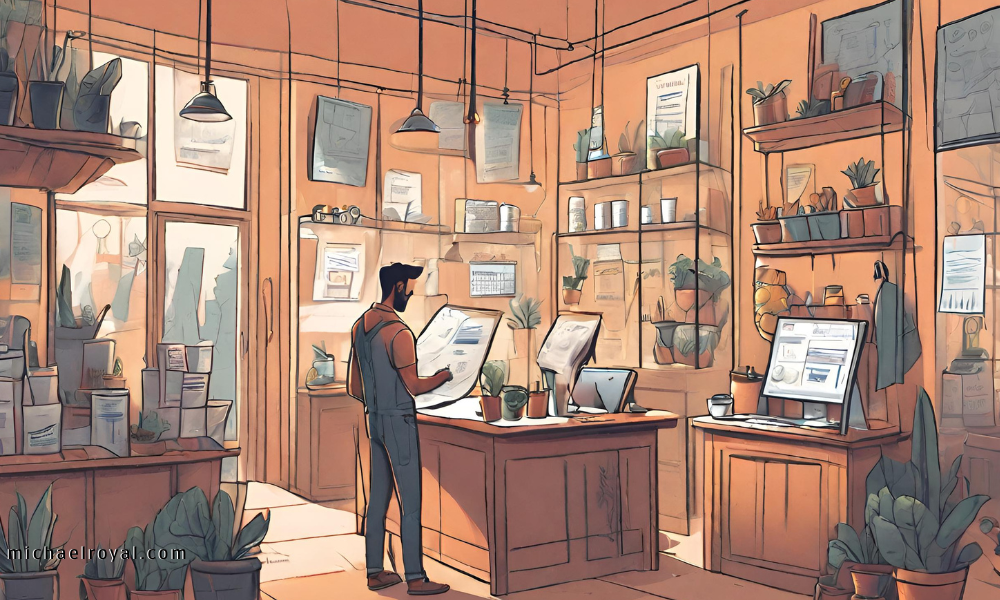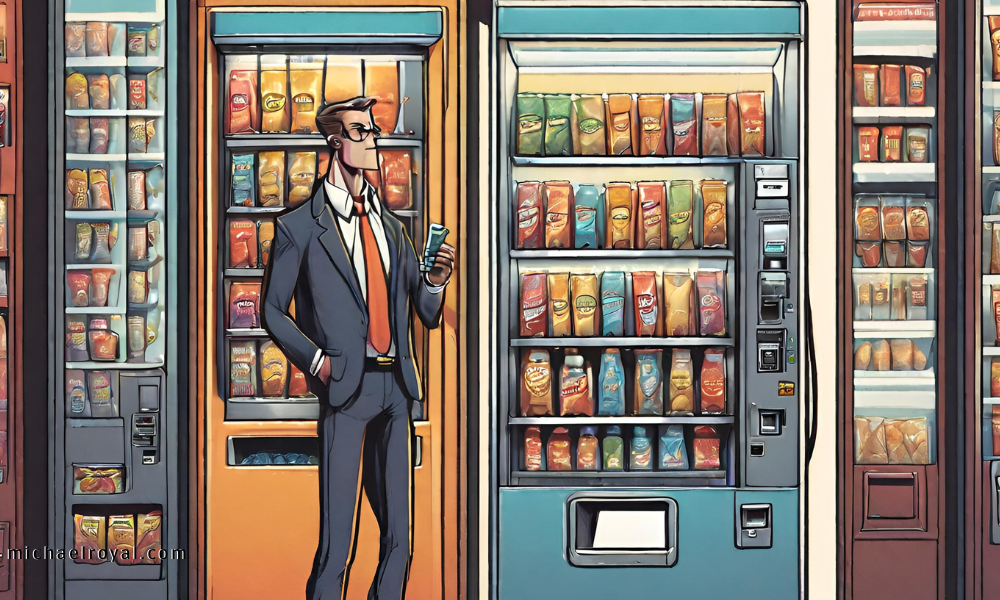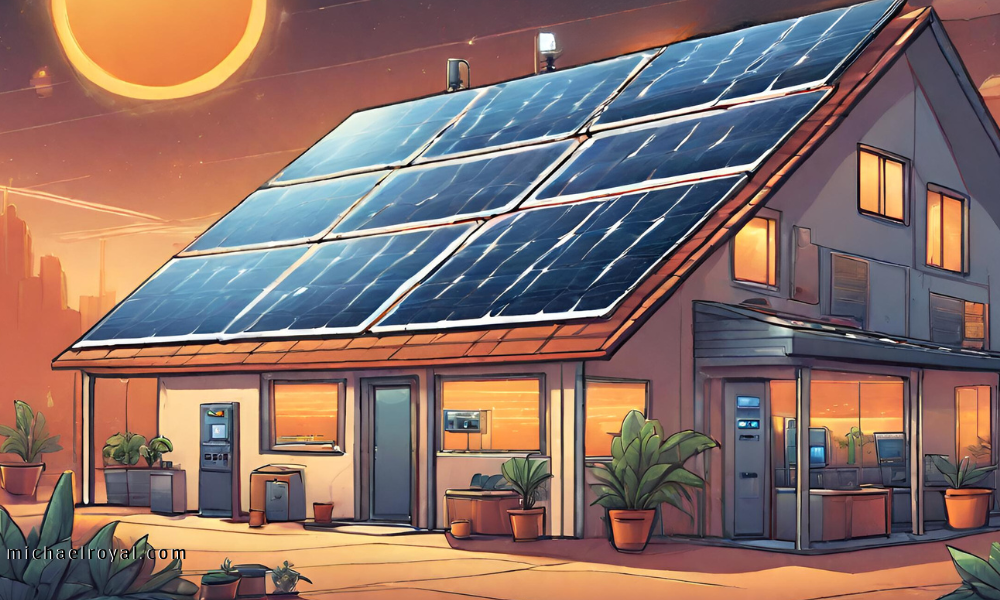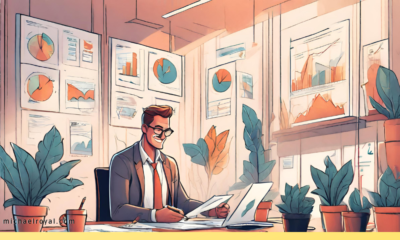Tech
5 Effective Ways to Optimize Small Business Expenses in One Day

Introduction
In this blog post, we will explore the expenses of a small business owner on a particularly expensive day. We will dive into the various costs incurred and gain insights into the financial responsibilities of running a business.
A Day in the Life of a Small Business Owner
Running a small business can be both exciting and challenging. As a small business owner, you have to juggle multiple responsibilities, from managing inventory to marketing your products. One crucial aspect of running a business is keeping track of your expenses. Let’s take a closer look at what a small business owner spent on a particularly expensive day.
Paying for Planners
One of the expenses on this day was a payment due for planners. The small business owner had to pay one-third of the total cost, which amounted to $29,700. Planners are essential for staying organized and keeping track of important tasks and appointments.
Shipping Labels and Mail
Shipping labels are necessary for sending out products to customers. On this day, the small business owner spent $800 on 42,000 blank shipping labels. They also sent out a lot of mail, which cost around $5,000. It’s important to ensure that products reach customers safely and on time.
Rent for Storefront and Warehouse
Operating a small business requires a physical space to showcase products. The small business owner had to pay $14,500 for rent, covering both the storefront and the warehouse. This cost ensures that customers can visit the store and that there is enough space to store inventory.
Notepads and Wholesale Catalog
To keep the business stocked with essential supplies, the small business owner ordered new notepads, costing approximately $5,800. Additionally, they had to reorder their wholesale catalog, which amounted to $524. Having these supplies helps in maintaining a smooth workflow and meeting customer demands.
Inventory Restocking
Maintaining a diverse range of products is crucial for attracting customers. The small business owner spent $1,400 on scrunchies, oven mitts, and pot holders, $1,200 on headbands, and $686 on restocking board games. They also purchased pens for $368. These investments ensure that the store remains well-stocked and appealing to customers.
Other Expenses
In addition to the above expenses, the small business owner spent $119 on Canva, a graphic design platform, to create visually appealing content. They also made a significant investment of $9,000 on wallets, although they had not received them yet. These expenses contribute to the overall success and growth of the business.
Total Expenses
When all these expenses are added up, the total spent on this particularly expensive day amounted to $69,400. Running a small business requires careful financial planning and management to ensure that expenses are covered while also generating profits.
In the next part of this blog series, we will explore strategies that small business owners can use to manage their expenses effectively and maximize their profits. Stay tuned for more insights into the world of small business ownership!
Planner Payments
The day started off with an important task as a small business owner – making a payment towards my planners. I had a one-third payment due, and it amounted to a whopping $29,700. This payment is crucial for maintaining inventory and fulfilling customer orders.
Planners are one of the main products I sell in my store, and they are incredibly popular among my customers. They help people stay organized, set goals, and manage their time effectively. As a small business owner, it’s important for me to have a steady supply of planners to meet the demand.
When I first started my business, I had to invest a significant amount of money in purchasing the initial stock of planners. It was a big risk, but I believed in the product and its potential to attract customers. Over time, the planners gained popularity, and now they are one of the top-selling items in my store.
Managing the inventory and fulfilling customer orders can be challenging at times. That’s why it’s crucial for me to make regular payments towards the planners. This helps me maintain a healthy stock level and ensures that I can meet the demands of my customers.
As a small business owner, every expense counts, and the one-third payment for the planners is a significant amount. It’s a reminder of the investment I have made in my business and the importance of keeping up with payments to suppliers.
Despite the financial pressure, I feel a sense of pride and accomplishment in being able to make these payments. It shows that my business is growing and thriving. I am grateful for the support of my customers who believe in the quality of my planners and continue to purchase them.
With the planner payment made, I can now focus on other aspects of running my business. There are still many expenses to take care of, but I am confident that with hard work and dedication, my small business will continue to flourish.
Shipping Labels
After taking care of the payment for my planners, the next item on my list was purchasing shipping labels. I needed 42,000 blank shipping labels, which cost me $800. It may seem like a lot, but with the amount of mail I had to send out, having a good supply of shipping labels was crucial.
Shipping labels are important because they help me keep track of packages and ensure that they reach their intended destinations. Each label contains important information such as the recipient’s address and my return address. Without these labels, it would be challenging to ship out all the orders efficiently.
With the labels in hand, I was ready to start packaging and shipping the orders. I carefully affixed each label to its respective package, making sure to double-check the addresses for accuracy. I wanted to provide the best service possible to my customers, and that meant ensuring that their orders were shipped promptly and accurately.
As a small business owner, it’s crucial to stay organized and have the necessary supplies on hand. Shipping labels may seem like a small detail, but they play a significant role in the smooth operation of my business. Without them, I would struggle to keep track of orders and provide excellent customer service.
Now that I had taken care of the shipping labels, it was time to move on to the next item on my list – paying the rent for my storefront and warehouse. Running a business requires careful planning and attention to detail, and I was determined to make it a success.
Renting a Storefront and Warehouse
Running a small business requires a lot of expenses, and one of the biggest expenses is renting a storefront and warehouse space. Today, I had to pay the rent for these spaces, which amounted to $14,500.
The storefront is where I display and sell my products to customers. It’s a cozy little shop with shelves filled with planners, notepads, scrunchies, and other items that I offer. The rent for the storefront allows me to have a physical presence in the community and attract customers who walk by or visit specifically to see what I have to offer.
The warehouse, on the other hand, is where I store all the inventory and supplies for my business. It’s a much larger space compared to the storefront, with shelves and storage units filled with boxes of planners, shipping labels, board games, and more. Renting a warehouse is essential for keeping my business organized and ensuring that I have enough stock to meet customer demands.
Paying $14,500 for the rent may seem like a lot, but it’s a necessary expense to keep my business running smoothly. Without these spaces, I wouldn’t be able to operate efficiently or provide a physical location for customers to visit.
As a small business owner, every expense adds up, and it’s important to carefully manage my finances. Renting a storefront and warehouse is just one of the many costs I have to consider, but it’s a crucial investment in the success of my business.
Inventory and Supplies
As a small business owner, it’s important to keep my inventory well-stocked. Today, I focused on ordering new supplies to meet the demands of my customers.
First, I needed to replenish my stock of notepads. These are essential for my customers to jot down their thoughts and ideas. I ordered a bunch of new notepads, which cost me around $5,800. It may seem like a lot, but I know they will sell quickly.
In addition to notepads, I also had to reorder my wholesale catalog. This catalog showcases all the products I offer and helps me attract new customers. The cost of reordering the catalog was $524. It may seem like a small amount compared to the notepads, but it’s an important investment in promoting my business.
By ensuring that my inventory is well-stocked and up-to-date, I can provide my customers with a wide range of options. It’s important to stay organized and keep track of what I need to order to meet the demands of my growing business.
Other Expenses
In addition to the expenses I mentioned earlier, there were some other costs that I had to take care of as a small business owner. One of these expenses was for a graphic design tool called Canva.
Canva is a helpful tool that allows me to create eye-catching promotional materials for my business. It has a wide range of templates and design elements that make it easy for me to create professional-looking graphics.
I paid $119 for a subscription to Canva. This subscription gives me access to additional features and resources that help me enhance my designs. It’s a worthwhile investment because it allows me to create visually appealing advertisements and social media posts to attract more customers.
With Canva, I can customize templates for flyers, posters, and social media graphics. I can add my own text, images, and logos to make them unique to my business. It saves me a lot of time and effort compared to designing everything from scratch.
Investing in tools like Canva is important for small business owners like me. It helps us create high-quality marketing materials without having to hire a professional graphic designer. Plus, it’s much more cost-effective in the long run.
So, even though it was an additional expense, paying $119 for Canva was a smart decision. It allows me to create visually appealing and engaging content to promote my business and attract more customers.
In the next part of my story, I’ll share more about the expenses I had to cover as a small business owner. Stay tuned to find out how I managed to handle all these costs and keep my business running smoothly.
Conclusion
Running a small business involves various financial obligations, as demonstrated by the expenses incurred on this particular day. As a small business owner, I had to carefully manage my finances to ensure the smooth operation of my business.
One of the major expenses I had to deal with was the payment for my planners. I had to make a one-third payment of $29,700, which was a significant amount. This was followed by the cost of shipping labels, which amounted to $800 for 42,000 labels. Since I sent out a lot of mail that day, the cost of shipping labels added up to around $5,000.
In addition to these expenses, I also had to pay rent for both my storefront and warehouse. The rent for both locations totaled $14,500. This was a necessary expense to maintain a physical presence for my business.
To keep my inventory well-stocked, I had to order new notepads, wholesale catalogs, and various other items. The notepads cost around $5,800, while the wholesale catalog reorder amounted to $524. I also spent $1,400 on scrunchies, oven mitts, and pot holders, $1,200 on headbands, and $686 on restocking board games for my storefront. Additionally, I purchased pens for $368 to ensure I had enough supplies for my customers.
Furthermore, I invested $9,000 in wallets that I hadn’t received yet. It was a significant amount, but I believed it would be a worthwhile addition to my product offerings.
When I added up all these expenses, the total came to a staggering $69,400. It was a large sum of money, but it was necessary to keep my business running smoothly and provide the best products and services to my customers.
Running a small business involves careful financial planning and decision-making. It requires balancing expenses and investments to ensure profitability and growth. Despite the high costs, I remained optimistic about the future of my business and the opportunities it would bring.
As a small business owner, I understood the importance of managing finances effectively and making smart financial decisions. It was a challenging but rewarding journey, and I was determined to make my business thrive.
Business
First Class vs. Business Class – Exploring the Ultimate Flight Experience

Introduction: Exploring the World of Premium Flight Travel
Welcome aboard, fellow travelers! Today, we embark on a journey to discover the world of premium flight travel. Have you ever wondered what it’s like to fly in first class or business class? Well, you’re about to find out!
When it comes to flying, there are different classes that offer varying levels of comfort and luxury. In this blog post, we will focus on two of the most sought-after classes: first class and business class. While both offer a step up from economy class, they each have their own unique features and perks.
So, fasten your seatbelts and get ready to soar through the skies as we delve into the distinctions between first class and business class. By the end of this journey, you’ll have a better understanding of what sets these classes apart and what makes them so special.
But before we dive in, let’s take a moment to understand why premium flight travel is so appealing. For many, it’s not just about reaching their destination; it’s about the experience along the way. Premium classes like first class and business class offer a level of comfort and luxury that can transform a long-haul flight into a truly enjoyable and memorable adventure.
Imagine reclining in a spacious seat that can transform into a fully flat bed, allowing you to sleep peacefully throughout the journey. Picture yourself savoring delectable meals prepared by top-notch chefs, accompanied by a glass of your favorite drink. And don’t forget the personalized service provided by dedicated flight attendants who cater to your every need.
Now that we have a glimpse of the world of premium flight travel, let’s delve deeper into the distinctions between first class and business class. Buckle up and get ready to explore the luxuries that await in these exclusive sections of the aircraft!
Understanding Business Class
Business class is a special type of seating and service that you can find on most international flights. It offers a lot more comfort and luxury compared to economy class. Let’s take a closer look at what business class has to offer.
Amenities
One of the main advantages of flying business class is the amenities that come with it. In business class, you can enjoy a spacious and comfortable seat that can often be transformed into a fully flat bed. This means you can stretch out and get a good night’s sleep during long flights.
Business class seats also come with direct access to the aisle, which means you don’t have to disturb other passengers when you want to get up or stretch your legs. Additionally, the seats are slightly bigger and nicer presented compared to economy class.
Seating
In business class, the seats are designed to provide maximum comfort. They are usually made of high-quality materials and offer more legroom, allowing you to stretch out and relax. Some airlines even provide seats with built-in massage functions to help you unwind during the flight.
Services
When you fly business class, you can expect top-notch service from the flight attendants. They are dedicated to making your journey as comfortable as possible. They will assist you with any requests you may have and ensure that you have everything you need throughout the flight.
Business class passengers also have access to exclusive airport lounges. These lounges are equipped with comfortable seating, delicious food and drinks, and sometimes even spa facilities. You can relax and enjoy these amenities before your flight, making the overall travel experience more enjoyable.
Overall Experience
Choosing to fly business class offers a luxurious experience. From the moment you arrive at the airport, you will be treated with priority. You can bypass the long lines and security checks by using private channels. This means you can save time and avoid the usual airport hustle and bustle.
Once onboard, you will be able to enjoy delicious meals that are specially prepared for business class passengers. You can also indulge in a selection of alcoholic beverages, including wine, champagne, and cocktails.
In summary, business class is a step above economy class, offering more comfort, better amenities, and superior service. It is the perfect choice for those who want to make their journey more enjoyable and relaxing.
Exploring First Class Luxury
Welcome back to our journey through the world of air travel! In this installment, we will delve into the realm of first class luxury and discover the unparalleled offerings it provides.
A World of Exclusivity
Stepping into the first class cabin is like entering a whole new world of exclusivity. The seats are plush and spacious, offering a level of comfort that is unmatched. Unlike business class, first class seats take up twice as much space, providing ample room to stretch out and relax.
But the luxury doesn’t stop there. In first class, you are treated like royalty. A dedicated flight attendant is at your service, ensuring that your every need is met. From assisting with your luggage to providing personalized attention throughout the flight, they are there to make your journey as comfortable as possible.
Unrestricted Space and True Beds
One of the most remarkable features of first class is the unrestricted space it offers. While business class may provide a flat surface to sleep on, first class takes it to a whole new level. Here, you will find a true bed, allowing you to sleep in complete comfort without any restrictions.
Imagine drifting off to sleep on a cloud-like mattress, with no worries about cramped spaces or uncomfortable angles. In first class, you can truly relax and rejuvenate, arriving at your destination feeling refreshed and ready to take on the world.
Exclusive Privileges
First class passengers also enjoy exclusive privileges that elevate their travel experience. As you make your way through the airport, you will be whisked away via private channels, bypassing the crowds and saving valuable time.
Once inside the airport, you will have access to fancy lounges reserved only for first class passengers. These luxurious spaces offer a tranquil oasis where you can unwind before your flight. Some airlines even provide separate terminals for first class travelers, ensuring a seamless and stress-free journey from start to finish.
A Truly Luxurious Experience
In a nutshell, first class is not just about comfort; it is an experience of pure luxury. From the moment you step onboard, you are transported into a world of exclusivity and opulence. The attention to detail, the personalized service, and the unmatched amenities make first class a truly unforgettable way to travel.
So, the next time you embark on a journey, consider treating yourself to the ultimate indulgence of first class. It’s an experience that will leave you feeling pampered, relaxed, and ready to take on the skies!
Distinguishing Features of First Class
First class is the epitome of luxury when it comes to air travel. It offers a range of exclusive features that are not available in business class. Let’s take a closer look at some of these distinguishing features:
1. Spacious Seats
In first class, the seats are much larger and more comfortable compared to business class. They take up twice as much space, allowing you to stretch out and relax during your flight. Some first-class seats even transform into a true bed, providing unrestricted space for a peaceful sleep.
2. Personalized Service
When you travel in first class, you are treated like royalty. You have a dedicated flight attendant who caters to your every need. They ensure that you have a comfortable and enjoyable journey, attending to your requests promptly and with a smile.
3. Exclusive Airport Privileges
First-class passengers enjoy a seamless airport experience. They have access to private channels and empty lounges, allowing them to bypass the crowds and save time. Some airlines even offer separate terminals exclusively for first-class passengers, providing a truly VIP experience.
4. Gourmet Dining
The meals served in first class are a step above those in business class. They are presented with elegance and attention to detail, offering a wide range of delicious options. First-class passengers can savor gourmet dishes prepared by renowned chefs, accompanied by a selection of fine wines and spirits.
5. Luxurious Amenities
First-class cabins are equipped with luxurious amenities to enhance your comfort. From plush blankets and pillows to noise-canceling headphones and high-quality toiletries, every detail is taken care of. Some airlines even provide private suites with doors, ensuring complete privacy during your journey.
In conclusion, while business class offers many comforts and amenities, first class takes luxury to a whole new level. It provides spacious seats, personalized service, exclusive airport privileges, gourmet dining, and luxurious amenities. If you’re looking for a truly indulgent and luxurious flying experience, first class is the way to go.
Cost and Accessibility
When it comes to flying in style, there is a big difference in cost between first class and business class tickets. Let’s take a closer look at the analysis of this cost difference.
Business class tickets are generally more affordable compared to first class tickets. They offer many of the same amenities and comforts as first class, but at a lower price. This makes business class a popular choice for travelers who want to enjoy a more comfortable journey without breaking the bank.
On the other hand, first class tickets are known for their luxury and exclusivity. They come with a higher price tag, but they offer an unparalleled experience. With first class, you get to enjoy spacious seats that can be transformed into a true bed. You also have access to dedicated flight attendants who cater to your every need. Additionally, you can breeze through the airport using private channels and enjoy the luxury of fancy lounges or even separate terminals.
While first class offers a truly luxurious experience, business class provides a great balance between comfort and affordability. It offers many of the same amenities as first class, such as flat beds, direct aisle access, and delicious meals. Plus, you still get to enjoy the perks of priority boarding and access to airport lounges.
Ultimately, the choice between first class and business class comes down to personal preference and budget. If you’re looking for a more affordable option that still provides a comfortable journey, business class is the way to go. But if you’re willing to splurge for an unforgettable experience, first class is worth considering.
Regardless of which class you choose, both business class and first class offer a significant upgrade from economy class. So, whether you’re traveling for business or pleasure, treat yourself to a more comfortable and enjoyable flight experience!
Real Experiences and Recommendations
Travelers Share Their Experiences
- John, a frequent traveler, shared his experience flying in business class. He mentioned how comfortable the seats were, especially with the ability to recline and turn into a flat bed. He enjoyed the privacy that the direct aisle access provided, allowing him to easily move around without disturbing others. The meals served were delicious and presented beautifully, making the journey even more enjoyable.
- Sarah, on the other hand, had the opportunity to fly first class on a special occasion. She couldn’t believe the level of luxury she experienced. The spacious seat allowed her to stretch out and relax, and she even had her own flight attendant dedicated to her needs. Sarah mentioned how she felt like a VIP, being able to bypass the long lines at the airport and enjoy the exclusive lounges and terminals. It truly made her trip unforgettable.
Recommendations for Choosing Your Class
- If you’re looking for a comfortable and enhanced travel experience, business class is a great choice. You’ll enjoy the extra legroom, better meals, and the convenience of direct aisle access. It’s a step up from economy class without breaking the bank.
- However, if you’re seeking the ultimate luxury and are willing to splurge, first class is the way to go. The extra space, true bed, and personalized service make it a truly indulgent experience. You’ll feel like royalty as you breeze through the airport and relax in exclusive lounges.
Final Thoughts
In the end, whether you choose business class or first class, both options offer a significant upgrade from economy. It’s all about your personal preferences and budget. So, the next time you plan a trip, consider treating yourself to a more comfortable and luxurious journey. Happy travels!
Conclusion: First Class vs Business Class
After exploring the differences between first class and business class, it’s clear that both offer a more comfortable and luxurious experience compared to economy class. However, there are some key distinctions that set them apart.
In business class, passengers can enjoy a flat bed and direct access to the aisle, allowing for a more restful journey. The seats are slightly larger and meals are presented in a nicer way. Business class passengers also have the opportunity to indulge in alcoholic beverages during their flight. Some airlines even offer the added privacy of doors for each seat.
On the other hand, first class takes luxury to a whole new level. While the seats may look similar to those in business class, they take up twice as much space, providing ample room to stretch out and relax. First class passengers can enjoy a true bed experience with unrestricted space. Additionally, they receive dedicated flight attendants who cater to their every need.
One of the biggest advantages of flying first class is the VIP treatment both in the air and on the ground. Passengers can breeze through the airport using private channels and have access to exclusive lounges or separate terminals. This ensures a seamless and stress-free travel experience.
In summary, business class is a great option for those seeking added comfort and amenities compared to economy class. It offers a more spacious seat, better meals, and the convenience of direct aisle access. First class, however, provides the ultimate luxurious experience with larger seats, a true bed, and personalized service. It’s a choice that guarantees a truly indulgent journey from start to finish.
Business
5 Essential Tips for a Profitable Vending Machine Business

Introduction
In this article, we will discuss some important tips for starting a successful vending business. Starting a vending business requires a long-term perspective and careful planning. Let’s dive in!
Thinking Long-Term
Starting a vending business is an exciting venture, but it’s important to have realistic expectations. It’s not about making quick money in the first year. Instead, it’s about thinking 10 years into the future. Just like any other business, a vending business requires time and effort to grow and succeed.
Continuous Reinvestment
One key aspect of running a successful vending business is understanding the need for continual reinvestment. This means that the money earned from the vending machines should be used to improve and expand the business. Whether it’s purchasing new machines, upgrading existing ones, or finding new locations, reinvesting in the business is crucial for long-term success.
Planning for the Future
When starting a vending business, it’s important to have a clear plan for the future. This includes setting goals, identifying target markets, and researching potential locations. By having a well-thought-out plan, you can make informed decisions and increase your chances of success.
Customer Satisfaction
In any business, customer satisfaction is key. When it comes to a vending business, it’s important to offer a variety of products that cater to the preferences of your target market. This could include healthy snacks, beverages, or even specialty items. By providing a range of options and ensuring the machines are well-maintained and stocked, you can attract and retain customers.
Adaptability and Flexibility
Lastly, a successful vending business requires adaptability and flexibility. Market trends and customer preferences can change over time, so it’s important to stay updated and willing to make adjustments to your offerings. This could mean introducing new products, exploring different locations, or even embracing cashless payment options.
In conclusion, starting a vending business is a long-term commitment that requires careful planning, continuous reinvestment, and a focus on customer satisfaction. By thinking ahead and being adaptable, you can increase your chances of building a successful vending business that stands the test of time.
Setting Realistic Expectations
Starting a vending business can be an exciting venture, but it’s important to set realistic expectations from the beginning. Many people may think that they will be successful and make a lot of money in the first year, but that’s not always the case.
When I started my own vending business, I made the mistake of thinking that I would be rolling in money right away. I quickly realized that this was not the best mindset to have. It took me two whole years to really start seeing a profit.
That’s why I believe it’s crucial for anyone who wants to start a vending business to think long-term. Instead of just focusing on making quick cash, it’s important to think about where you want your business to be in 10 years.
Running a successful vending business requires more than just relying on the money you make from the vending machines. It requires continual reinvestment into the business. Just like any other business, you need to put money back into it in order to grow and thrive.
So, instead of living for dollar bills, it’s important to have a bigger vision for your vending business. Think about how you can expand, improve, and offer better products and services to your customers. This will not only help you stay competitive in the market but also ensure long-term success.
Setting realistic expectations also means understanding that there will be challenges along the way. It’s not always smooth sailing, and there may be times when you face setbacks. But if you have a clear vision and are willing to put in the hard work, you can overcome these obstacles and achieve your goals.
In conclusion, starting a vending business is not a get-rich-quick scheme. It requires patience, perseverance, and a long-term mindset. By setting realistic expectations and focusing on continual growth, you can build a successful vending business that stands the test of time.
Planning and Research for Your Vending Business
Before you jump into starting your own vending business, it’s important to take the time to plan and do some research. This will help set you up for success in the long run.
1. Identify Your Target Market
Think about who your customers will be. Are you targeting students, office workers, or busy parents? Understanding your target market will help you choose the right locations and products for your vending machines.
2. Choose the Right Locations
Location is key when it comes to running a successful vending business. Look for high-traffic areas where your target market is likely to be. Places like schools, office buildings, and shopping centers can be great options.
3. Research Your Competition
Take the time to research other vending businesses in your area. What products are they offering? How are they pricing their items? This information can help you make informed decisions about your own business.
4. Create a Business Plan
A business plan is like a roadmap for your vending business. It outlines your goals, strategies, and financial projections. This will help you stay focused and organized as you start and grow your business.
5. Calculate Your Costs
Running a vending business requires some upfront investment. Calculate the costs of purchasing vending machines, stocking them with products, and any other expenses like maintenance or permits. This will help you determine how much money you need to get started.
Remember, starting a vending business is not a get-rich-quick scheme. It requires hard work, planning, and a long-term mindset. By doing thorough planning and research, you’ll be setting yourself up for success in the future.
Choosing the Right Locations
Location is crucial for a vending business. If you want to be successful, you need to carefully consider where you place your vending machines. Here are some important factors to keep in mind:
1. Foot Traffic
Look for areas with a lot of people passing by. Places like shopping malls, office buildings, and schools can be great options. The more people that walk by your vending machine, the more potential customers you’ll have.
2. Target Audience
Think about who your target audience is and where they are likely to be. For example, if you’re selling healthy snacks, you might want to place your vending machine in a gym or fitness center. Understanding your customers’ needs and preferences will help you choose the right locations.
3. Competition
Take a look at the competition in the area. If there are already several vending machines selling similar products, it might be challenging to attract customers. Try to find locations where there is less competition or where you can offer something unique.
4. Safety
Safety is essential when choosing locations for your vending machines. Avoid areas with high crime rates or places that are known for vandalism. You want to protect your investment and ensure that your machines are in a secure environment.
5. Convenience
Consider the convenience factor for your customers. Choose locations that are easily accessible and where people can quickly grab a snack or a drink. Busy areas with limited food options can be ideal for a vending business.
Remember, choosing the right locations can make a big difference in the success of your vending business. Take your time to research and analyze different areas before making a decision. And always think about the future – where will your vending machines thrive in the next 10 years?
Maintaining and Restocking Your Vending Business
Regular maintenance and restocking are essential for a successful vending business.
Starting a vending business is an exciting venture, but it’s important to remember that success doesn’t happen overnight. Just like any other business, it requires careful planning and long-term thinking. Once you’ve set up your vending machines and started making sales, the work doesn’t stop there. Regular maintenance and restocking are key to keeping your business running smoothly.
1. Regular Maintenance
Maintaining your vending machines is crucial to ensure they are in good working condition. This includes cleaning the machines regularly to keep them hygienic and presentable. Wipe down the surfaces, remove any dust or debris, and check for any signs of damage. If you notice any issues, such as malfunctioning buttons or a broken coin slot, it’s important to address them promptly to avoid any disruptions in service.
2. Restocking
Keeping your vending machines well-stocked is essential for customer satisfaction and maximizing your profits. Regularly check the inventory levels and restock items as needed. Make sure to rotate the products, placing the freshest items at the front, and removing any expired or stale items. It’s also a good idea to monitor which products are selling well and adjust your inventory accordingly.
3. Building Relationships
Maintaining a good relationship with your suppliers is crucial for a successful vending business. Regularly communicate with them to ensure a steady supply of products and negotiate favorable terms. Building a strong network of reliable suppliers can help you restock efficiently and keep your vending machines filled with popular items.
4. Customer Feedback
Listening to your customers is vital for improving your vending business. Encourage feedback from your customers and take their suggestions into consideration. This will not only help you understand their preferences but also give you valuable insights into which products are in demand. By catering to your customers’ needs, you can increase customer satisfaction and attract more business.
Remember, maintaining and restocking your vending business requires dedication and a long-term perspective. By staying on top of regular maintenance, keeping your machines stocked with popular items, building strong supplier relationships, and listening to customer feedback, you can ensure the success of your vending business for years to come.
Adapting to Market Trends
When starting a vending business, it’s important to stay updated with market trends and adapt your offerings accordingly. This means keeping an eye on what people are interested in and making changes to your products to meet their needs.
For example, let’s say you started your vending business selling traditional snacks like chips and candy bars. But over time, you notice that more and more people are looking for healthier options. Instead of sticking to your old products, you decide to add some fresh fruits, granola bars, and yogurt cups to your vending machine.
By adapting to the market trends and offering healthier choices, you not only attract more customers but also increase your chances of success. People are more likely to buy from a vending machine that offers options that align with their current preferences.
But how do you stay updated with market trends? Well, it’s important to do some research. Keep an eye on what’s popular in the food and snack industry. Read magazines, browse the internet, and even talk to other vending business owners to see what products are selling well.
Once you have an idea of the current trends, it’s time to make some changes to your offerings. This could mean adding new products, removing ones that aren’t selling well, or even rebranding your vending machine to attract a specific target market.
Remember, the key to a successful vending business is to adapt and evolve. Don’t be afraid to try new things and take risks. By staying updated with market trends and offering what people want, you’ll increase your chances of long-term success.
Conclusion: Starting a Vending Business
Starting a vending business is an exciting venture, but it requires a long-term perspective and careful planning. As we have learned, expecting immediate success and thinking only about making money in the first year is not the best approach.
When I first started my vending business, I made the mistake of focusing solely on the dollar bills. I thought I would be rolling in money right away, but that wasn’t the case. It took me two years to realize that this mindset was not sustainable.
To be successful in the vending industry, it’s important to think about the future. Instead of living for dollar bills, we need to think about the next ten years. This means considering the growth potential of the business, reinvesting profits, and continuously improving our offerings.
Just like any other business, a vending business requires continual reinvestment. This means using the money earned to upgrade machines, expand product offerings, and explore new locations. By reinvesting, we can attract more customers, increase sales, and ultimately, achieve long-term success.
It’s crucial to have a clear plan in place before starting a vending business. This includes conducting market research, identifying target customers, and finding the right locations for vending machines. By understanding the needs and preferences of our customers, we can provide products that they will love and keep coming back for.
Additionally, it’s important to stay updated on industry trends and adapt to changing consumer demands. By offering a variety of healthy snacks, drinks, and even specialty items, we can cater to different preferences and attract a wider customer base.
In conclusion, starting a vending business is not a get-rich-quick scheme. It requires patience, perseverance, and a long-term perspective. By thinking ten years into the future and continually reinvesting in the business, we can build a successful venture that provides a steady income and a fulfilling lifestyle. So, if you’re considering starting a vending business, remember to plan for the long haul and think beyond just the dollar bills.
Business
Top 5 Effective Ways for Selling Quality Solar Systems

Introduction: The Importance of Selling Quality Solar Systems
Welcome to our blog article where we will be discussing why it is crucial to sell quality solar systems. In today’s world, many companies may be tempted to sell cheap solar systems in order to make more money quickly. However, this short-term approach can lead to a lot of problems and recalls, which can ultimately harm both the business and the customer.
At first glance, selling cheap solar systems may seem like a good idea. After all, who doesn’t love a bargain? But what these companies fail to realize is that taking this approach can have serious consequences in the long run. Installers may disappear, leaving customers with unresolved issues. And when there are recalls on these cheap systems, it can cost the business millions of dollars.
Instead of focusing on short-term gains, we believe in taking a long-term view. Our goal is to protect both our business and our customers by selling quality solar systems. By prioritizing quality, we ensure that our installers can continue to provide excellent service and support. This not only benefits us but also our customers who can rely on us for their solar system needs.
It’s important for people to understand that simply putting a cheap solar system on the roof isn’t enough. Quality matters. When you invest in a quality solar system, you can expect it to perform well and last for a long time. It’s not just about saving money upfront; it’s about making a smart investment that will pay off in the long run.
So, in this blog article, we will delve deeper into why selling quality solar systems is essential. We will explore the benefits it brings to both the business and the customer. By the end, we hope to convince you that quality should always be a top priority when it comes to solar systems.
The Risks of Selling Cheap Solar Systems
Selling cheap solar systems may seem like a lucrative option at first. However, it can have serious consequences in the long run.
As the owner of a solar system business, I understand the temptation to sell cheap systems. After all, it would mean more money in the short term. But what many people don’t realize is that these cheap systems often come with a host of problems.
One of the biggest risks of selling cheap solar systems is the high chance of recalls. These systems are often made with low-quality materials and lack proper testing. This means that they are more likely to malfunction or even pose a safety hazard. In the long run, these recalls can cost the business millions of dollars.
Not only does selling cheap systems put the business at risk, but it also puts the customer at risk. When a customer invests in a solar system, they expect it to be reliable and efficient. Cheap systems may not meet these expectations, leaving the customer disappointed and frustrated.
Furthermore, selling cheap systems can lead to the downfall of installers. If the business relies on selling low-quality systems, customers will eventually realize the problems and seek out better options. This means that the installers will lose business and may even have to shut down.
Instead of taking the short-term view, I believe in protecting both the business and the customer by selling quality solar systems. By investing in high-quality materials and thorough testing, we can ensure that our systems are reliable and efficient.
While it may be tempting to go for the quick profit, it’s important to remember that long-term success comes from providing value to customers. People are slowly starting to realize that a cheap solar system may not be the best option. It’s not just about slapping a system on the roof; it’s about providing a long-lasting solution that benefits both the customer and the installer.
So, let’s steer away from the risks of selling cheap solar systems and focus on delivering quality. It’s a win-win situation for everyone involved.
The Benefits of Selling Quality Solar Systems
Selling quality solar systems has numerous advantages for all parties involved. When we prioritize quality over cheapness, everyone wins. Let’s take a closer look at the benefits:
1. Long-Term Sustainability
By selling quality solar systems, we ensure the longevity of our business. While it may be tempting to sell cheap systems for quick profits, it often leads to problems down the line. These cheap systems may have recalls or issues, causing installers to disappear and leaving customers frustrated. By focusing on quality, we protect our business and ensure that we can continue serving our customers for years to come.
2. Customer Satisfaction
When customers invest in solar systems, they expect them to work efficiently and effectively. Cheap systems may save them money initially, but they often come with hidden costs. These systems may not perform as expected, leading to disappointment and frustration. By selling quality solar systems, we prioritize customer satisfaction. Our customers can trust that the systems they purchase will meet their needs and provide long-lasting benefits.
3. Installer Reliability
Selling quality solar systems not only benefits our business and customers but also our installers. When we sell cheap systems, installers often face numerous problems during installation. These problems can lead to delays, recalls, and ultimately, a negative impact on their reputation. By providing quality systems, we support our installers and ensure that they can continue their work with confidence. This not only benefits them but also strengthens our partnership with them.
4. Environmental Impact
Choosing quality solar systems also has a positive impact on the environment. Cheap systems may not be as efficient or durable, leading to more waste and a shorter lifespan. By selling quality systems, we contribute to a greener future. These systems are designed to be energy-efficient and have a longer lifespan, reducing the overall environmental footprint.
5. Industry Credibility
Lastly, selling quality solar systems helps build our credibility within the industry. When we prioritize quality over cheapness, we establish ourselves as a reliable and trustworthy provider. This reputation attracts more customers and strengthens our position in the market. By consistently delivering quality systems, we become a go-to choice for those seeking reliable solar solutions.
In conclusion, selling quality solar systems brings numerous benefits to our business, customers, installers, the environment, and our industry credibility. It’s important to remember that investing in quality pays off in the long run. Let’s continue to prioritize quality and provide the best solar solutions for everyone involved.
Changing Perspectives
While some may still believe that cheap solar systems are a viable option, there is a gradual shift in perspective. People are starting to realize that quality is important when it comes to solar systems.
For a long time, there was a temptation to sell cheap solar systems in order to make more money quickly. But what many didn’t realize was that this short-term gain would ultimately lead to the downfall of their business.
Installers who chose to sell cheap systems often faced numerous problems. These systems had a high rate of recalls, costing the installers millions of dollars. As a result, many installers disappeared, leaving their customers without support or assistance.
However, there are those who have taken a different approach. They understand the importance of selling quality solar systems, not just for the sake of their business, but also for the benefit of their customers.
By selling quality systems, these installers are able to protect their business in the long run. They build a reputation for reliability and trustworthiness, ensuring that they will still be around to provide support and maintenance for their customers.
Slowly but surely, people are starting to come around to this new way of thinking. They are realizing that simply slapping a cheap solar system on their roof won’t guarantee good results. Quality matters.
Choosing a quality solar system means investing in a reliable and efficient source of clean energy. It means having peace of mind knowing that the system will perform well and last for years to come.
So, as the perspective on cheap solar systems begins to change, more and more people are opting for quality. They understand that it’s not just about saving money in the short term, but about making a wise investment for the future.
By embracing this shift in perspective, we can ensure that both our businesses and our customers thrive. It’s time to prioritize quality and protect the future of solar energy.
Conclusion: The Importance of Selling Quality Solar Systems
After carefully considering the short-term gains versus the long-term sustainability, it is clear that selling quality solar systems is of utmost importance. It not only ensures the success of our business but also protects the interests of our customers.
While it may be tempting to sell cheap solar systems to make a quick profit, this approach ultimately leads to problems and recalls down the line. Installers disappear, and customers are left with faulty systems that don’t meet their needs.
Instead, our focus should be on selling quality solar systems that are reliable and efficient. By doing so, we protect our business by building a strong reputation and ensuring customer satisfaction. This, in turn, allows us to continue serving our customers for years to come.
It’s important for people to understand that simply slapping a cheap solar system on the roof won’t guarantee good results. Quality matters, and investing in a reliable system is essential for long-term success.
As the industry evolves, more and more people are realizing the importance of quality solar systems. They understand that cutting corners may save money initially, but it can lead to costly repairs and disappointment in the long run.
So, let’s prioritize quality over short-term gains. By selling quality solar systems, we not only protect our business but also ensure the satisfaction and trust of our valued customers. Together, we can make a positive impact on the solar industry and contribute to a sustainable future.
-

 Business1 year ago
Business1 year ago3 Disastrous Businesses You Should Never Buy
-

 Blog7 months ago
Blog7 months ago50 Things To Stop Doing In 2024
-

 Business8 months ago
Business8 months ago5 Effective Ways to Boost Business Growth
-

 Business1 year ago
Business1 year agoHow Love Saved My Business
-

 Entrepreneur7 months ago
Entrepreneur7 months agoWhat is taylor swift net worth
-

 Business1 year ago
Business1 year ago5 Essential Tips for a Profitable Vending Machine Business
-

 Business1 year ago
Business1 year agoStarting a Handmade Jewelry Business on a Budget
-

 Business8 months ago
Business8 months agoTop Strategies for Staying Healthy and Building Wealth












